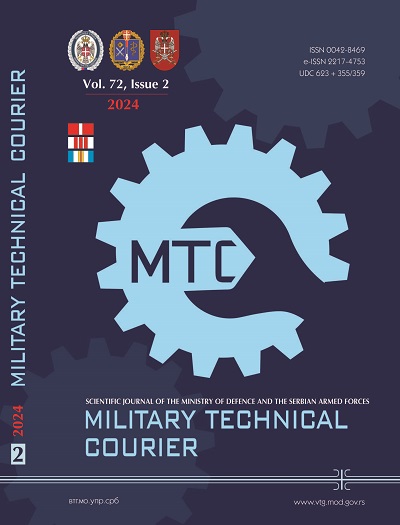Supervised machine learning algorithms for brain signal classification
Abstract
Introduction/purpose: The brain wave application is widespread in recent years, especially in the applications that aid the impaired people suffered from amputation or paralysis. The objective of this research is to assess how well different supervised machine learning algorithms classify brain signals, with an emphasis on improving the precision and effectiveness of brain-computer interface applications.
Method: In this work, brain signal data was analyzed using a number of well-known supervised learning models, such as Support Vector Machines (SVM) and Neural Networks (NN). The data set was taken from a previous study. Twenty five participants imagined moving their right arm (elbow and wrist) while the brain signals were recorded during that process. The dataset was prepared for the analysis by the application of meticulous pre-processing and feature extraction procedures. Then the resulting data were subjected to classification.
Results: The study highlights how crucial feature selection and model modification are for maximizing classification results. Supervised machine learning methods have great potential for classifying brain signals, particularly SVM and NN.
Conclusion: The use of SVM and NN has the potential to completely transform the creation of cutting-edge brain-computer interfaces. The integration of these models with real-time data should be investigated in future studies.
References
Ahmed, A.H., Al-Hamadani, M.N.A. & Satam, I.A. 2022. Prediction of COVID-19 disease severity using machine learning techniques. Bulletin of Electrical Engineering and Informatics, 11(2), pp.1069-1074. Available at: https://doi.org/10.11591/eei.v11i2.3272.
Al-Hamadani, M.N. 2023. Classification and analysis of the MNIST dataset using PCA and SVM algorithms. Vojnotehnički glasnik/Military Technical Courier, 71(2), pp. 221-238. Available at: https://doi.org/10.5937/vojtehg71-42689.
Amin, H.U., Mumtaz, W., Subhani, A.R., Saad, M.N.M. & Malik, A.S. 2017. Classification of EEG Signals Based on Pattern Recognition Approach. Frontiers in Computational Neuroscience, 11, art.number:103, pp.1-12. Available at: https://doi.org/10.3389/fncom.2017.00103.
Al-Aziz, A., Muntakim, A.-H. & Ahmed, K. 2021. No Regular Behavior Pattern in Neural Network Execution – A Matlab Experience. International Journal of Computer Application, 174(19), pp.39-46. Available at: https://doi.org/10.5120/ijca2021921087.
de Brito Guerra, T.C., Nóbrega, T., Morya, E., de M. Martins, A. & de Sousa, V.A. 2023. Electroencephalography Signal Analysis for Human Activities Classification: A Solution Based on Machine Learning and Motor Imagery. Sensors, 23(9), art.number:4277. Available at: https://doi.org/10.3390/s23094277.
Huang, J.-S., Li, Y., Chen, B.-Q., Lin, C. & Yao, B. 2020. An Intelligent EEG Classification Methodology Based on Sparse Representation Enhanced Deep Learning Networks. Frontiers in Neuroscience, 14, art.number:808. Available at: https://doi.org/10.3389/fnins.2020.00808.
Kuptsov, P.V. & Stankevich, N.V. 2024. Modeling of the Hodgkin–Huxley neural oscillators dynamics using an artificial neural network. Izvestiya VUZ Applied Nonlinear Dynamics, 32(1), pp.72-95. Available at: https://doi.org/10.18500/0869-6632-003079.
Ma, X., Qiu, S. & He, H. 2020. Multi-channel EEG recording during motor imagery of different joints from the same limb. Scientific Data, 7, art.number:191, pp.1-9. Available at: https://doi.org/10.1038/s41597-020-0535-2.
Ortega-Fernandez, I., Sestelo, M. & Villanueva, N.M. 2024. Explainable generalized additive neural networks with independent neural network training. Statistics and Computing, 34, art.number:6. Available at: https://doi.org/10.1007/s11222-023-10320-5.
Páez-Amaro, R.T., Moreno-Barbosa, E., Hernández-López, J.M., Zepeda-Fernández, C.H., Rebolledo-Herrera, L.F. & de Celis-Alonso, B. 2022. EEG motor imagery classification using machine learning techniques. Revista Mexicana de Fisica, 68(4), art.number:041102. Available at: https://doi.org/10.31349/RevMexFis.68.041102.
Ramírez-Arias, F.J., García-Guerrero, E.E., Tlelo-Cuautle, E., Colores-Vargas, J.M., García-Canseco, E., López-Bonilla, O.R., Galindo-Aldana, G.M. & Inzunza-González, E. 2022. Evaluation of Machine Learning Algorithms for Classification of EEG Signals. Technologies, 10(4), art.number:79. Available at: https://doi.org/10.3390/technologies10040079.
Wen, T., Du, Y., Pan, T., Huang, C. & Zhang, Z. 2021. A Deep Learning-Based Classification Method for Different Frequency EEG Data. Computational and Mathematical Methods in Medicine, 2021, art.ID:1972662. Available at: https://doi.org/10.1155/2021/1972662.
Copyright (c) 2024 Ihab A. Satam, Róbert Szabolcsi

This work is licensed under a Creative Commons Attribution 4.0 International License.
Proposed Creative Commons Copyright Notices
Proposed Policy for Military Technical Courier (Journals That Offer Open Access)
Authors who publish with this journal agree to the following terms:
Authors retain copyright and grant the journal right of first publication with the work simultaneously licensed under a Creative Commons Attribution License that allows others to share the work with an acknowledgement of the work's authorship and initial publication in this journal.
- Authors are able to enter into separate, additional contractual arrangements for the non-exclusive distribution of the journal's published version of the work (e.g., post it to an institutional repository or publish it in a book), with an acknowledgement of its initial publication in this journal.
- Authors are permitted and encouraged to post their work online (e.g., in institutional repositories or on their website) prior to and during the submission process, as it can lead to productive exchanges, as well as earlier and greater citation of published work (See The Effect of Open Access).

